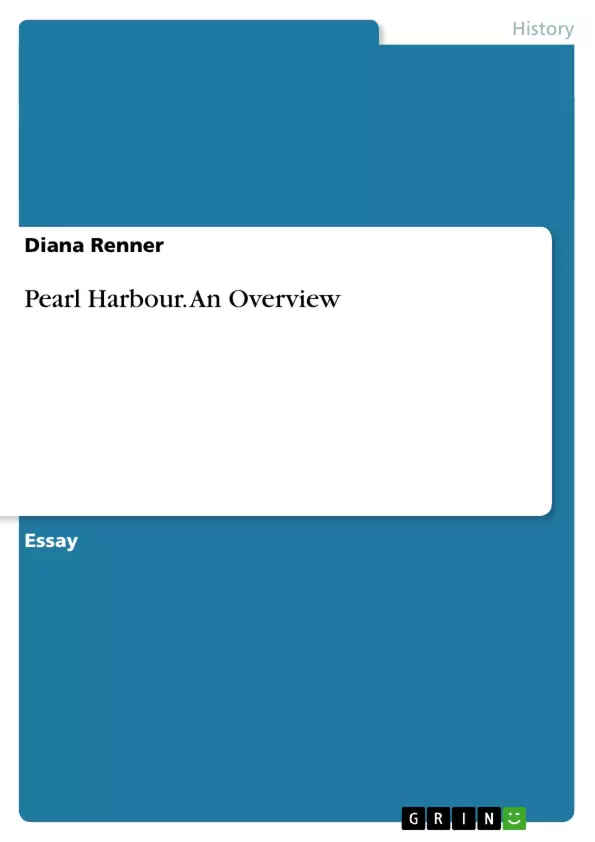The state of Hawaii is the 50th of the United States of America and maybe one of the most
popular places in the world. On O’ahu, the third largest of the Hawaiian Islands, many wellknown
tourist attractions like Hanauma Bay or Waikiki Beach, can be found. Furthermore
there is a place on O’ahu which owns a great piece of the American and also the world’s
history. Pearl Harbor is a harbor located at the south coast of O’ahu and is generally regarded
as an extraordinary event in American history, remembered as the first time since the War of
1812 America has been attacked on its home soil by another country. The attack on Pearl
Harbor was an unexpected and surprising attack of Japan to the United State naval base at
Pearl Harbor. It took place on the morning of Sunday, December the 7th in 1941. The result of
the war was a decisive victory for Japan and a war declaration of war of the USA on the
Empire of Japan. Thus the USA entered World War II on the side of the Allies. [...]
Inhaltsverzeichnis (Table of Contents)
- Pearl Harbor
- The Tension between the USA and Japan
- The Modus Vivendi
- The Japanese Attack on Pearl Harbor
- Who is Guilty?
Zielsetzung und Themenschwerpunkte (Objectives and Key Themes)
This text aims to provide an in-depth analysis of the events leading up to the attack on Pearl Harbor. It explores the escalating tensions between the United States and Japan, highlighting the role of political maneuvering and diplomatic failures. The text focuses on the decision-making processes of both nations, emphasizing the complexities and ambiguities involved in the lead-up to the attack.
- The role of diplomacy and political negotiations in the lead-up to the attack
- The impact of the Japanese expansionist policy in Asia and its implications for US interests
- The complex motivations and decision-making processes of both the US and Japan
- The significance of the attack on Pearl Harbor as a pivotal event in American history
- The question of blame and responsibility for the attack
Zusammenfassung der Kapitel (Chapter Summaries)
- Pearl Harbor: This chapter introduces the topic of Pearl Harbor and its historical significance, emphasizing its position as the first time since the War of 1812 that America was attacked on its own soil. It establishes the attack as a pivotal event in American history and its significance in the context of World War II.
- The Tension between the USA and Japan: This section delves into the growing tension between the United States and Japan leading up to the attack. It outlines key events, including the escalation of the Second Sino-Japanese War, the formation of the Axis Powers, and the US embargo on Japan. The text discusses the American government's concerns regarding Japan's expansionist ambitions and its desire to secure a dominant position in the Pacific Ocean.
- The Modus Vivendi: This chapter focuses on the attempts by both the US and Japan to reach a compromise through negotiations. It describes President Roosevelt's proposal of a "modus vivendi," a temporary agreement aimed at easing tensions, and its rejection by Japan. The text explores the differing viewpoints and concerns of the US and Japan, including China's apprehension about any compromise with Japan. The chapter highlights the deteriorating diplomatic situation and the growing possibility of conflict.
- The Japanese Attack on Pearl Harbor: This chapter analyzes the events leading up to the Japanese attack on Pearl Harbor. It discusses the communication of the final war message, the missed opportunities for warning the US Pacific Fleet, and the lack of decisive action by American leaders. The text examines the crucial decisions made by both sides and their impact on the course of events.
Schlüsselwörter (Keywords)
The key words associated with this text include Pearl Harbor, the attack, World War II, US-Japan relations, diplomacy, negotiations, expansionism, Axis Powers, modus vivendi, blame, responsibility, historical significance. These keywords highlight the core concepts of the text, which focus on the historical context of the attack, the diplomatic failures, and the evolving relationship between the United States and Japan.
- Quote paper
- Diana Renner (Author), 2007, Pearl Harbour. An Overview, Munich, GRIN Verlag, https://www.grin.com/document/269174



